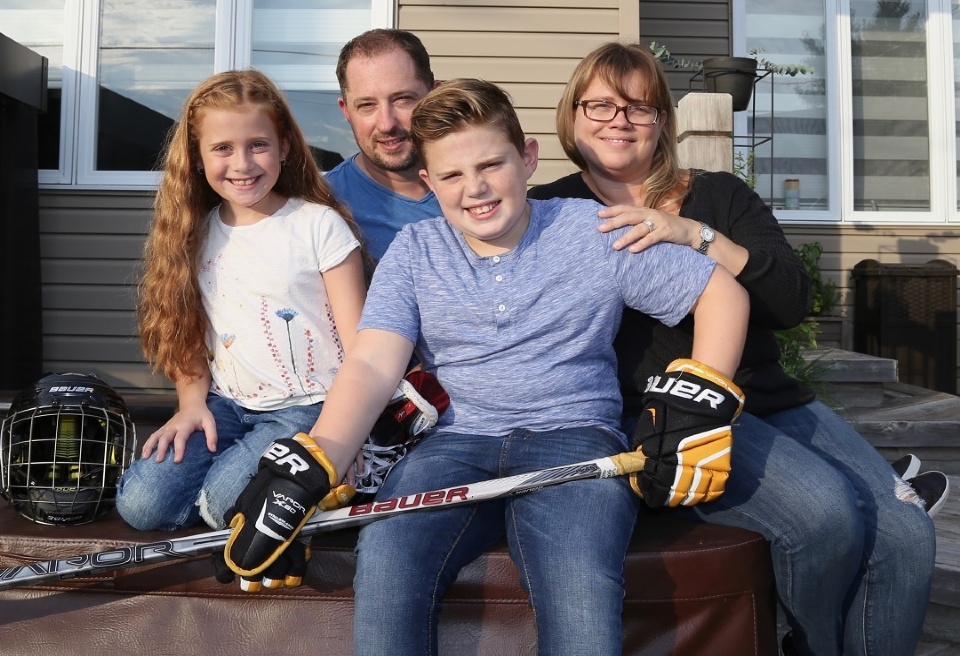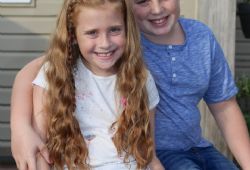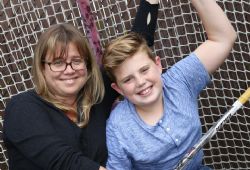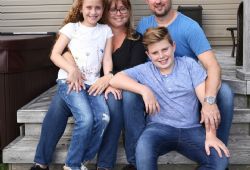Jack Hickman, a young, vibrant
boy from Fabreville, was diagnosed with Juvenile Arthritis at the tender age of
seven years old. Jack initially experienced swelling in his big toe; then the
pain spread to his other big toe and ankles. After seeing Jack’s pain, his
parents Rosina and Jim sought help from many physicians. As part of their
journey, they met with pediatric rheumatologist Dr. Gaëlle Chédeville and Nurse
Gillian Taylor (now retired) at the Montreal Children`s Hospital. It was Dr.
Chédeville who diagnosed Jack.
In the beginning, Jack took 42
pills per week. Some mornings, Jack couldn’t walk down the stairs at home, but
being Jack, he slid down the stairs himself on hind quarters. He went to school
with crutches. On good days, by lunch hour, he laid his crutches down because
he felt better. His classmates thought Jack was faking; Jack persevered and
wrote a school project about Juvenile Arthritis so his classmates could better
understand his disease.
Dr. Chédeville suggested that
Jack take Methotrexate injections which Jack resisted initially. Months later,
Jack and his family realized that the medication was working. He could play
soccer and some other sports. Running was still difficult, though. Although Methotrexate helped, Dr. Chédeville
made another suggestion; that Jack be injected with Enbrel (a biological
injection). Within just weeks, there was a visible difference.
4,500 Youth in Quebec Suffer from
Juvenile Diabetes
When we think of arthritis, we
think of a disease that affects the elderly. Most of us don’t realize that this
debilitative, painful disease also affects children, teens and young adults.
When it afflicts young people, it’s referred to as Juvenile Arthritis, which
affects children of all ages and backgrounds. This condition affects approximately 24,000 young people across Canada,
including a total of 4,500 youth in Quebec.
Juvenile Arthritis is
considered to be an autoimmune disease. Usually, an immune system fights off
harmful bacteria and viruses. In the case of an autoimmune disorder, the immune
system attacks some of the body’s own healthy cells and tissues. Symptoms of Juvenile Arthritis include
swollen joints, pain and stiffness that won’t subside and usually affects
knees, hands and feet and is worse in the morning. Other symptoms include
limping, excessive clumsiness, high fever and a skin rash, swelling of the
lymph nodes in the neck or other parts of the body. Sometimes these symptoms
improve and go away (a remission) or they return (a flare). Juvenile Arthritis
can cause eye inflammation, growth problems and bones and joints to grow
unevenly.
It’s not easy to confirm that
a child has Juvenile Arthritis. Many tests must be completed in order to
confirm the diagnosis. (See the sidebar
for more information on the various types of Juvenile Arthritis.)
Juvenile Arthritis not only
affects a child, but the entire family, as it involves a child’s social and
school activities. Exercise is the key to reducing symptoms and maintains
function and range of motion for joints. Children can still participate in
sports when symptoms are under control. Swimming is a beneficial activity
because it uses several joints and muscles simultaneously without putting
excess weight on them. During a flare, children may be unable to participate in
activities or concentrate on school work.
Jack’s Support System
Jack`s biggest fan is his
sister Jenna. “My sister Jenna is 9 years old and she’s like a teddy bear, but even
better. For every single needle that I ever took in my life, she was there
holding my hand if I was in pain,” says Jack.
“She would try to make me laugh so I could stop thinking about the pain.
Honestly, I would not know what I would do if she wasn’t there right next to me
every step of my journey with arthritis.”
Still to this day after being
pain free for about 3 years, Jack says that Jenna holds his hand while he takes
his injections. “This is why my sister is the best sister in the world; she is
the most supportive person I know. She is also my number one fan when I play
hockey and soccer,” explains Jack.
Tammie Agostino, a teacher at
Our Lady of Peace Elementary School, was Jack’s teacher for grades 1, 3 and
6. Agostino became close with Jack and
his family over the years. She describes Jack as being charismatic, witty,
loving and a real go-getter. Although Agostino was not his teacher at the time,
she recalls when Jack first learned that he had juvenile arthritis and how his
world changed instantly.
She noticed that Jack’s morale
deteriorated as she watched his pain when he walked by her classroom door. Agostino
went to Jack’s home on Friday evenings to hold his hand while he received his
injections. Agostino knew that with Jack’s personality, he would not need her
for long. After a while, Jack adjusted
and adapted to his disorder. Jack’s disease and his medical appointments made
him miss some school. He was easily distracted in class and at times, had to
leave school early due to his pain.
Some days the pain was
unbearable. Agostino tutored Jack at home to help him catch up with schoolwork.
“Jack and his family have brought much joy and optimism into my life. I truly
hope that I have done the same for them,” says Agostino.
“We are thankful and
appreciative of all the support we have received from the staff at Our Lady of
Peace Elementary School as well as the care that Dr. Chédeville and Nurse
Gillian Taylor provided,” says Jack’s mother.
Bjillian MacKinnon, 32, who
currently works for the Juvenile Arthritis Society in Montreal, used to be a
childcare educator and “marathon coach”. Fitness was her passion. MacKinnon’s
life was turned upside down when she learned she had a painful form of
arthritis called Ankylosing Spondylitis, which causes bones to fuse together
and difficult breathing along with many other painful symptoms.
MacKinnon met Jack two years
ago at Kids on the Move Camp, a camp for children with arthritis, at
Camp Papillon in St. Alphonse. Jack was 11 at the time and MacKinnon worked as
Camp Coordinator. MacKinnon explains that Jack was the kind of kid who always
looked out for his friends. Jack was comfortable at camp because he finally did
not have to explain his pain to others. This time, nobody thought he was
faking.Jack and MacKinnon became good
friends, and two years ago they ran the 5 km run for the Scotia Bank. Although
they were both in pain and perhaps slower than anticipated, they finished the
race without stopping. They plan to run this race together each year. “My whole
mission in life is to raise awareness and serve others,” says MacKinnon.
Suzanne Brazeau, a mother of 4
children, has known Jack for some time, as her son Zack plays hockey on the
same team as Jack. Both boys are
passionate about hockey and encourage one another. Brazeau describes Jack as inspirational; a
leader amongst his peers, yet claims that Jack possesses “an old soul”. Because
Jack was never one to say “Poor me”, Brazeau says that she and her family
realize that challenges can be overcome. Whenever Brazeau faces a challenge,
she thinks of Jack. “Jack has made an impression on me that will last my
lifetime,” she says.
Moving Forward in Life
Today, Jack is thirteen years
old and is currently pain-free. He still requires three injections per week. He
continues to play hockey with the Delta Laval team. He now proudly holds the position of
spokesperson for the Arthritis Society for Childhood Arthritis. Jack recently
gave a speech for 300 people at the George Russell Gala in Montreal to spread
awareness about Juvenile Arthritis and to raise funds for Kids on the Move
Camp. Jack no longer attends Kids on the Move Camp because he feels
other kids need the help more than him.
Jack currently attends Loyola High
School where he looks forward to new challenges and opportunities. Although he
must watch his diet (Jack adores cooking), he enjoys the occasional iced cappuccino.
Of course, having an Italian Nonna, he eats homemade ravioli, gnocchi and
lasagna, which are the key to his heart. Jack`s advice for others is; “Never
lose hope; there is always a light at the end of the tunnel.”
Jack’s parents’ advice for other
parents whose children have Juvenile Arthritis is to get informed and be
patient. It can take time to find the right medication. “Building a strong
support system on all levels is key,” says Jack’s mom. “We are optimistic for the future.”
There are seven different
types of Juvenile Idiopathic Arthritis that affect children and teenagers under
16 years of age, including;
- Oligoarthritis (two different types) – arthritis affecting 1 to 4 joints
- Polyarthritis (two different types) – arthritis affecting more than 5 joints
- Systemic Arthritis – arthritis accompanied by fever and rash
- Enthesitis-related Arthritis – arthritis and inflammation of tendon insertions
- Psoriatic Arthritis – arthritis accompanied by psoriasis

 In The Latest Issue:
In The Latest Issue:






 BY:
BY: 

Tweet
Share